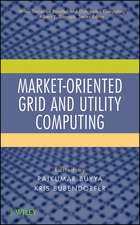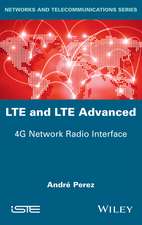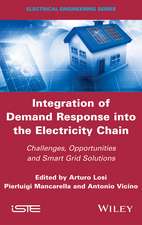Fog and Edge Computing – Principles and Paradigms: Wiley Series on Parallel and Distributed Computing
Autor R Buyyaen Limba Engleză Hardback – 28 feb 2019
Din seria Wiley Series on Parallel and Distributed Computing
- 14%
 Preț: 722.82 lei
Preț: 722.82 lei - 9%
 Preț: 966.88 lei
Preț: 966.88 lei - 9%
 Preț: 1010.51 lei
Preț: 1010.51 lei - 9%
 Preț: 1043.04 lei
Preț: 1043.04 lei - 9%
 Preț: 883.95 lei
Preț: 883.95 lei - 9%
 Preț: 958.11 lei
Preț: 958.11 lei - 9%
 Preț: 1148.99 lei
Preț: 1148.99 lei - 9%
 Preț: 1041.33 lei
Preț: 1041.33 lei - 9%
 Preț: 1027.95 lei
Preț: 1027.95 lei - 9%
 Preț: 855.39 lei
Preț: 855.39 lei - 9%
 Preț: 1349.96 lei
Preț: 1349.96 lei - 9%
 Preț: 1042.36 lei
Preț: 1042.36 lei - 9%
 Preț: 1149.31 lei
Preț: 1149.31 lei - 9%
 Preț: 1132.51 lei
Preț: 1132.51 lei - 9%
 Preț: 831.27 lei
Preț: 831.27 lei - 9%
 Preț: 984.96 lei
Preț: 984.96 lei - 9%
 Preț: 1123.77 lei
Preț: 1123.77 lei - 9%
 Preț: 1129.03 lei
Preț: 1129.03 lei - 9%
 Preț: 1011.94 lei
Preț: 1011.94 lei - 9%
 Preț: 765.84 lei
Preț: 765.84 lei - 9%
 Preț: 849.58 lei
Preț: 849.58 lei - 9%
 Preț: 718.25 lei
Preț: 718.25 lei - 9%
 Preț: 734.14 lei
Preț: 734.14 lei - 9%
 Preț: 771.63 lei
Preț: 771.63 lei - 9%
 Preț: 701.27 lei
Preț: 701.27 lei - 9%
 Preț: 692.84 lei
Preț: 692.84 lei - 9%
 Preț: 715.23 lei
Preț: 715.23 lei - 9%
 Preț: 1032.74 lei
Preț: 1032.74 lei - 32%
 Preț: 969.36 lei
Preț: 969.36 lei - 32%
 Preț: 1302.92 lei
Preț: 1302.92 lei - 31%
 Preț: 1039.20 lei
Preț: 1039.20 lei - 31%
 Preț: 1022.97 lei
Preț: 1022.97 lei - 32%
 Preț: 938.97 lei
Preț: 938.97 lei - 32%
 Preț: 606.19 lei
Preț: 606.19 lei - 32%
 Preț: 575.46 lei
Preț: 575.46 lei - 31%
 Preț: 758.33 lei
Preț: 758.33 lei - 32%
 Preț: 863.08 lei
Preț: 863.08 lei - 32%
 Preț: 781.12 lei
Preț: 781.12 lei - 32%
 Preț: 577.29 lei
Preț: 577.29 lei - 32%
 Preț: 640.10 lei
Preț: 640.10 lei - 30%
 Preț: 738.50 lei
Preț: 738.50 lei - 30%
 Preț: 507.94 lei
Preț: 507.94 lei - 31%
 Preț: 700.08 lei
Preț: 700.08 lei
Preț: 796.60 lei
Preț vechi: 875.39 lei
-9% Nou
Puncte Express: 1195
Preț estimativ în valută:
152.45€ • 165.54$ • 128.06£
152.45€ • 165.54$ • 128.06£
Carte tipărită la comandă
Livrare economică 22 aprilie-06 mai
Preluare comenzi: 021 569.72.76
Specificații
ISBN-13: 9781119524984
ISBN-10: 1119524989
Pagini: 512
Dimensiuni: 152 x 229 x 28 mm
Greutate: 0.9 kg
Editura: Wiley
Seria Wiley Series on Parallel and Distributed Computing
Locul publicării:Hoboken, United States
ISBN-10: 1119524989
Pagini: 512
Dimensiuni: 152 x 229 x 28 mm
Greutate: 0.9 kg
Editura: Wiley
Seria Wiley Series on Parallel and Distributed Computing
Locul publicării:Hoboken, United States
Notă biografică
Cuprins
List of Contributors xix Preface xxiii Acknowledgments xxvii Part I Foundations 1 1 Internet of Things (IoT) and New Computing Paradigms 3 Chii Chang, Satish Narayana Srirama, and Rajkumar Buyya 1.1 Introduction 3 1.2 Relevant Technologies 6 1.3 Fog and Edge Computing Completing the Cloud 8 1.3.1 Advantages of FEC: SCALE 8 1.3.2 How FEC AchievesThese Advantages: SCANC 9 1.4 Hierarchy of Fog and Edge Computing 13 1.5 Business Models 16 1.6 Opportunities and Challenges 17 1.7 Conclusions 20 References 21 2 Addressing the Challenges in Federating Edge Resources 25 Ahmet Cihat Baktir, Cagatay Sonmez, CemErsoy, Atay Ozgovde, and Blesson Varghese 2.1 Introduction 25 2.2 The Networking Challenge 27 2.3 The Management Challenge 34 2.4 Miscellaneous Challenges 40 2.5 Conclusions 45 References 45 3 Integrating IoT + Fog + Cloud Infrastructures: System Modeling and Research Challenges 51 Guto Leoni Santos,Matheus Ferreira, Leylane Ferreira, Judith Kelner, Djamel Sadok, Edison Albuquerque, Theo Lynn, and Patricia Takako Endo 3.1 Introduction 51 3.2 Methodology 52 3.3 Integrated C2F2T Literature by Modeling Technique 55 3.4 Integrated C2F2T Literature by Use-Case Scenarios 65 3.5 Integrated C2F2T Literature by Metrics 68 3.6 Future Research Directions 72 3.7 Conclusions 73 Acknowledgments 74 References 75 4 Management and Orchestration of Network Slices in 5G, Fog, Edge, and Clouds 79 Adel Nadjaran Toosi, RedowanMahmud, Qinghua Chi, and Rajkumar Buyya 4.1 Introduction 79 4.2 Background 80 4.3 Network Slicing in 5G 83 4.4 Network Slicing in Software-Defined Clouds 87 4.5 Network Slicing Management in Edge and Fog 91 4.6 Future Research Directions 93 4.7 Conclusions 96 Acknowledgments 96 References 96 5 Optimization Problems in Fog and Edge Computing 103 Zoltán Ádám Mann 5.1 Introduction 103 5.2 Background / RelatedWork 104 5.3 Preliminaries 105 5.4 The Case for Optimization in Fog Computing 107 5.5 Formal Modeling Framework for Fog Computing 108 5.6 Metrics 109 5.6.5 Further Quality Attributes 112 5.7 Optimization Opportunities along the Fog Architecture 113 5.8 Optimization Opportunities along the Service Life Cycle 114 5.9 Toward a Taxonomy of Optimization Problems in Fog Computing 115 5.10 Optimization Techniques 117 5.11 Future Research Directions 118 5.12 Conclusions 119 Acknowledgments 119 References 119 Part II Middlewares 123 6 Middleware for Fog and Edge Computing: Design Issues 125 Madhurima Pore, Vinaya Chakati, Ayan Banerjee, and Sandeep K. S. Gupta 6.1 Introduction 125 6.2 Need for Fog and Edge Computing Middleware 126 6.3 Design Goals 126 6.4 State-of-the-Art Middleware Infrastructures 128 6.5 System Model 129 6.6 Proposed Architecture 131 6.7 Case Study Example 136 6.8 Future Research Directions 137 6.9 Conclusions 139 References 139 7 A Lightweight Container Middleware for Edge Cloud Architectures 145 David von Leon, LorenzoMiori, Julian Sanin, Nabil El Ioini, Sven Helmer, and Claus Pahl 7.1 Introduction 145 7.2 Background/RelatedWork 146 7.3 Clusters for Lightweight Edge Clouds 149 7.4 Architecture Management - Storage and Orchestration 152 7.5 IoT Integration 159 7.6 Security Management for Edge Cloud Architectures 159 7.7 Future Research Directions 165 7.8 Conclusions 166 References 167 8 Data Management in Fog Computing 171 Tina Samizadeh Nikoui, Amir Masoud Rahmani, and Hooman Tabarsaied 8.1 Introduction 171 8.2 Background 172 8.3 Fog Data Management 174 8.4 Future Research and Direction 186 8.5 Conclusions 186 References 188 9 Predictive Analysis to Support Fog Application Deployment 191 Antonio Brogi, Stefano Forti, and Ahmad Ibrahim 9.1 Introduction 191 9.2 Motivating Example: Smart Building 193 9.3 Predictive Analysis with FogTorch 197 9.4 Motivating Example (continued) 206 9.5 Related Work 207 9.6 Future Research Directions 214 9.7 Conclusions 216 References 217 10 Using Machine Learning for Protecting the Security and Privacy of Internet of Things (IoT) Systems 223 Melody Moh and Robinson Raju 10.1 Introduction 223 10.2 Background 234 10.3 Survey of ML Techniques for Defending IoT Devices 242 10.4 Machine Learning in Fog Computing 248 10.4.1 Introduction 248 10.5 Future Research Directions 252 10.6 Conclusions 252 References 253 Part III Applications and Issues 259 11 Fog Computing Realization for Big Data Analytics 261 Farhad Mehdipour, Bahman Javadi, AniketMahanti, and Guillermo Ramirez-Prado 11.1 Introduction 261 11.2 Big Data Analytics 262 11.3 Data Analytics in the Fog 267 11.4 Prototypes and Evaluation 272 11.4.1 Architecture 272 11.4.2 Configurations 274 11.5 Case Studies 277 11.6 Related Work 282 11.7 Future Research Directions 287 11.8 Conclusions 287 References 288 12 Exploiting Fog Computing in Health Monitoring 291 Tuan Nguyen Gia and Mingzhe Jiang 12.1 Introduction 291 12.2 An Architecture of a Health Monitoring IoT-Based System with Fog Computing 293 12.3 Fog Computing Services in Smart E-Health Gateways 297 12.4 System Implementation 304 12.5 Case Studies, Experimental Results, and Evaluation 308 12.6 Discussion of Connected Components 313 12.7 Related Applications in Fog Computing 313 12.8 Future Research Directions 314 12.9 Conclusions 314 References 315 13 Smart Surveillance Video Stream Processing at the Edge for Real-Time Human Objects Tracking 319 Seyed Yahya Nikouei, Ronghua Xu, and Yu Chen 13.1 Introduction 319 13.2 Human Object Detection 320 13.3 Object Tracking 327 13.4 Lightweight Human Detection 335 13.5 Case Study 337 13.6 Future Research Directions 342 13.7 Conclusions 343 References 343 14 Fog Computing Model for Evolving Smart Transportation Applications 347 M. Muzakkir Hussain,Mohammad Saad Alam, and M.M. Sufyan Beg 14.1 Introduction 347 14.2 Data-Driven Intelligent Transportation Systems 348 14.3 Mission-Critical Computing Requirements of Smart Transportation Applications 351 14.4 Fog Computing for Smart Transportation Applications 354 14.5 Case Study: Intelligent Traffic Lights Management (ITLM) System 359 14.6 Fog Orchestration Challenges and Future Directions 362 14.7 Future Research Directions 364 14.8 Conclusions 369 References 370 15 Testing Perspectives of Fog-Based IoT Applications 373 Priyanka Chawla and Rohit Chawla 15.1 Introduction 373 15.2 Background 374 15.3 Testing Perspectives 376 15.4 Future Research Directions 393 15.5 Conclusions 405 References 406 16 Legal Aspects of Operating IoT Applications in the Fog 411 G. Gultekin Varkonyi, Sz. Varadi, and Attila Kertesz 16.1 Introduction 411 16.2 RelatedWork 412 16.3 Classification of Fog/Edge/IoT Applications 413 16.4 Restrictions of the GDPR Affecting Cloud, Fog, and IoT Applications 414 16.5 Data Protection by Design Principles 425 16.6 Future Research Directions 430 16.7 Conclusions 430 Acknowledgment 431 References 431 17 Modeling and Simulation of Fog and Edge Computing Environments Using iFogSim Toolkit 433 Redowan Mahmud and Rajkumar Buyya 17.1 Introduction 433 17.2 iFogSim Simulator and Its Components 435 17.3 Installation of iFogSim 436 17.4 Building Simulation with iFogSim 437 17.5 Example Scenarios 438 17.6 Simulation of a Placement Policy 450 17.7 A Case Study in Smart Healthcare 461 17.8 Conclusions 463 References 464 Index 467

















